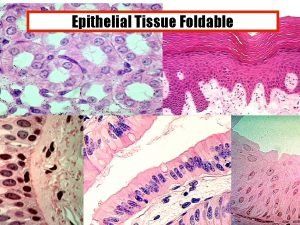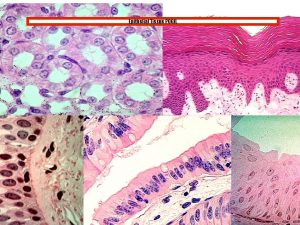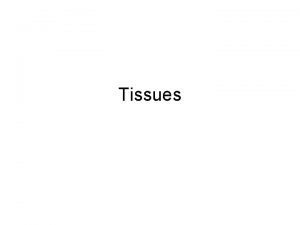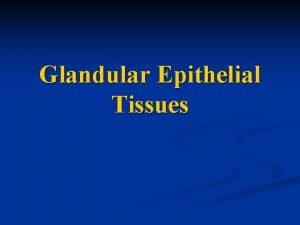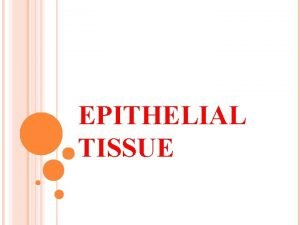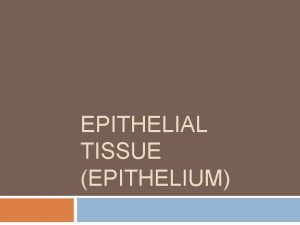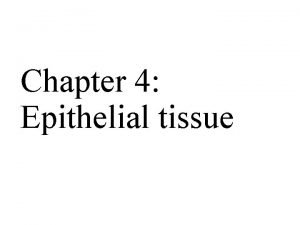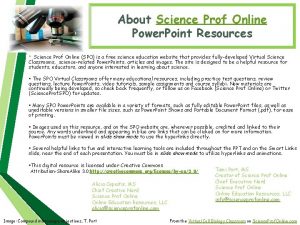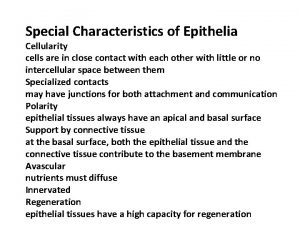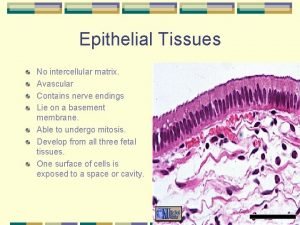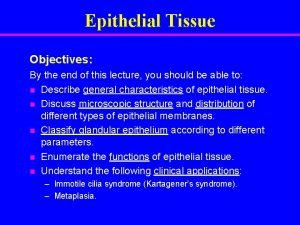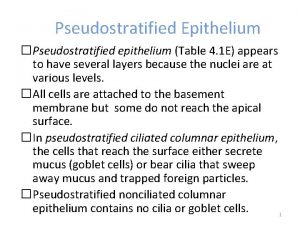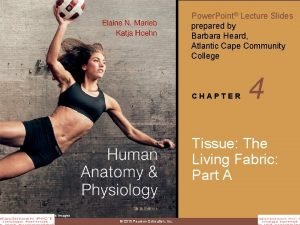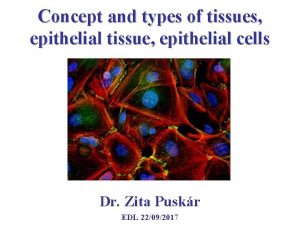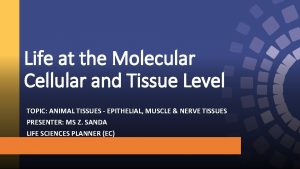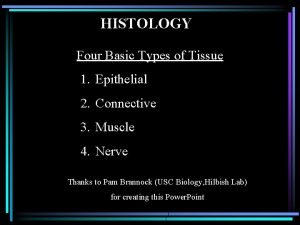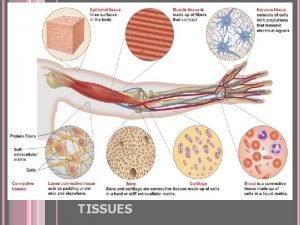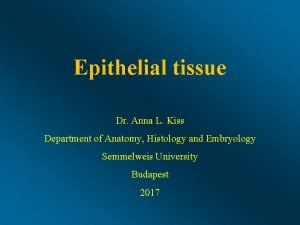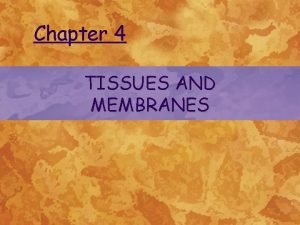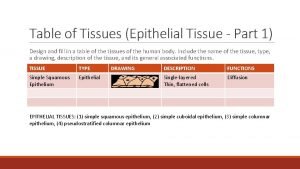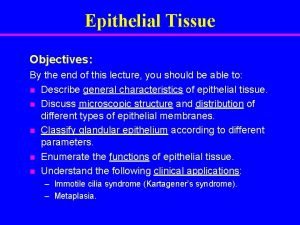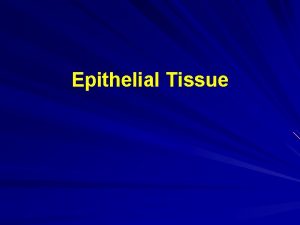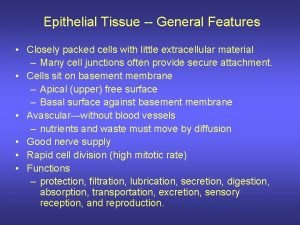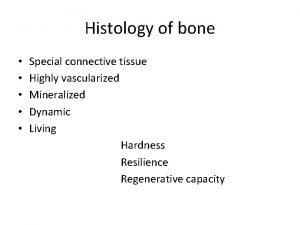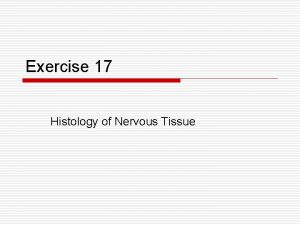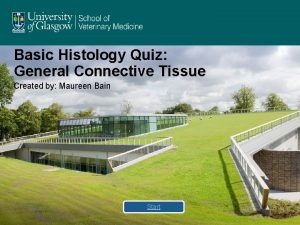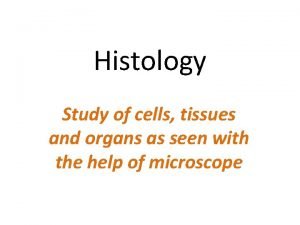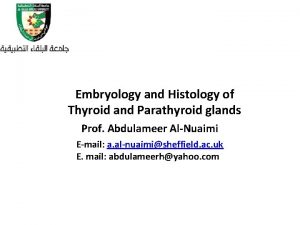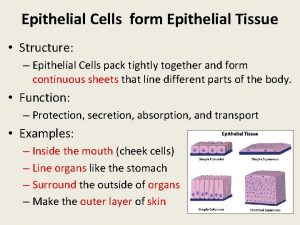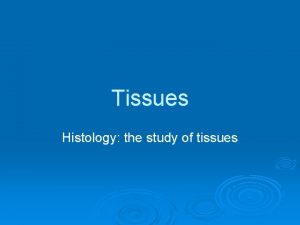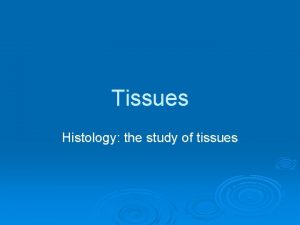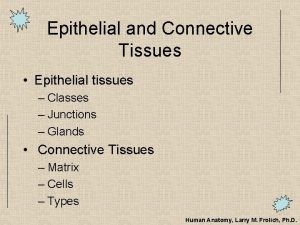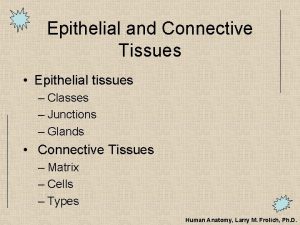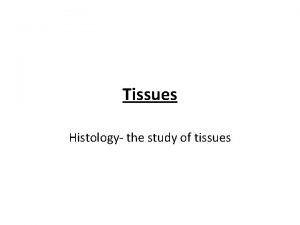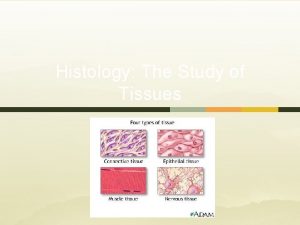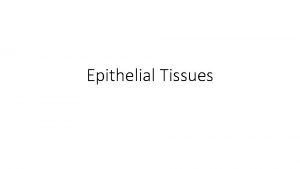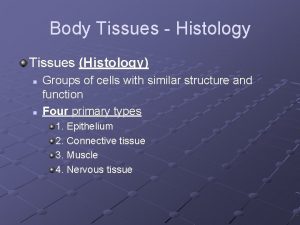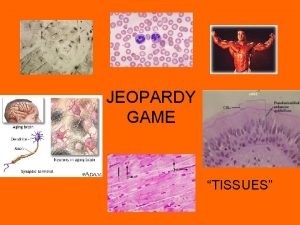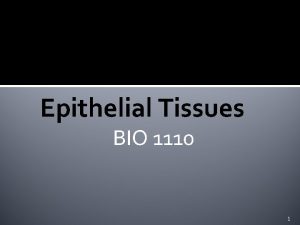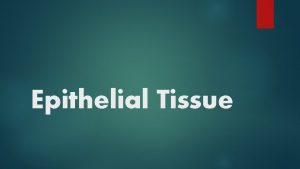HISTOLOGY The Study of Tissues EPITHELIAL TISSUE FACTS







































- Slides: 39

HISTOLOGY The Study of Tissues

EPITHELIAL TISSUE FACTS Free surface – open to its surroundings Basal surface – attached to underlying tissue Basement membrane – “glue” that attaches epithelial tissue to other tissue – is avascular Has ability to repair itself through mitosis Classified by # of layers and shape of cells that make up those layers

SIMPLE EPITHELIUM One cell thick Named based on shape of cell: squamous cuboidal columnar Found in linings of stomach, in blood vessels, and air sacs of lungs

SQUAMOUS

CUBOIDAL

COLUMNAR

STRATIFIED EPITHELIAL More than one layer thick Named for cells at surface Found in areas where protection is needed

STRATIFIED

PSEUDOSTRATIFIED EPITHELIUM

GLANDULAR EPITHELIUM Forms the secreting surface of a gland Glands are either exocrine or endocrine

EXOCRINE Merocrine § Glands secrete without losing cellular material § Examples include: § Enzyme secreting glands

EXOCRINE Apocrine § Gland has cytoplasm in secretions § Examples include: § Mammary glands

EXOCRINE Holocrine § Glands have secretions made of disintegrated cells § Examples include: § Sebaceous glands

ENDOCRINE Glands are ductless Secrete hormones directly into bloodstream Discussed further in ch 10

CONNECTIVE TISSUE

EXTRACELLULAR MATRIX

CT PROPER Loose connective Not very strong Very flexible Ex: attaches skin to underlying tissues

CT PROPER Dense irregular Part of skin = dermis Collagen fibers oriented in all directions Ex: also encapsulates your organs

CT PROPER Dense regular Collagen fibers line up in same direction Strong binding Ex: tendons & ligaments

CT PROPER Adipose tissue Cells fill with oil, enlarge, & get pushed close together Support, protection and insulation Also stores nutrients for future energy

CARTILAGE

HYALINE CARTILAGE Both firm and resilient. Collagen there, but hard to see “hard plastic” Found in bridge of nose, costal cart. of ribs, ends of bones

FIBROCARTILAGE Tough binding and resilient support Packed with collagen that runs parallel to one another Found between vertebra

ELASTIC CARTILAGE Highly flexible support Not as much collagen = elastic fibers instead Stretchy – “soft plastic” Found in tips of nose & outer ear

BONE AND BLOOD Bone AKA Osseous tissue Secrete ground substance, fibers, collagen, & fluid Ground substance hardens thru calcification Blood AKA Vascular tissue Has cells (WBC, RBC) Has ground substance (proteins in blood) Has fluid (plasma) Has fibers that can join together to form clots

MEMBRANES

Membranes are both epithelial and connective tissues 3 categories: • Mucous • Synovial • Serous

MUCOUS Notice spelling Line digestive, urinary, and reproductive tracts

SYNOVIAL Found around moveable joints Secretes synovial fluid

SEROUS Lines and protects internal organs Form thin double layers

TISSUE REPAIR WOW!!!

STROMAL “Supporting” cells that provide structure/support for parenchymal cells Structural cells – form infrastructure Repair – scar tissue

PARENCHYMAL “Performance” cells that provide the actual function of the tissue Do the work the tissue is designed to do

QUESTION: In order for function to be fully restored, which of these would need to be repaired after damage?

QUESTION: In order for function to be fully restored, which of these would need to be repaired after damage? PARENCHYMAL

Labile cells – cells that undergo mitosis regularly & quickly • Ex – epithelial (skin) cells REGENERATION TERMS

Labile cells – cells that undergo mitosis regularly & quickly • Ex – epithelial (skin) cells Stable cells – cells that do not usually undergo mitosis, but can if needed • Ex – undamaged bone tissue REGENERATION TERMS

Labile cells – cells that undergo mitosis regularly & quickly • Ex – epithelial (skin) cells Stable cells – cells that do not usually undergo mitosis, but can if needed • Ex – undamaged bone tissue Permanent cells – cells that do not undergo mitosis • Ex – nervous tissue REGENERATION TERMS

Labile cells – cells that undergo mitosis regularly & quickly • Ex – epithelial (skin) cells Stable cells – cells that do not usually undergo mitosis, but can if needed • Ex – undamaged bone tissue Permanent cells – cells that do not undergo mitosis • Ex – nervous tissue Other factors to consider: • Circulation • Nutrition • Age REGENERATION TERMS
 Histology of epithelial tissue pogil activity
Histology of epithelial tissue pogil activity Epithelial tissue histology pogil
Epithelial tissue histology pogil Body tissue
Body tissue Chapter 3 cells and tissues answer key
Chapter 3 cells and tissues answer key Body tissues chapter 3 cells and tissues
Body tissues chapter 3 cells and tissues Eisonophil
Eisonophil Stained cheek cell
Stained cheek cell Layers of epithelial tissue
Layers of epithelial tissue Simple squamous epithelium
Simple squamous epithelium Epitelio glandular holocrino
Epitelio glandular holocrino Simple squamous epithelium location
Simple squamous epithelium location Epithelial tissue
Epithelial tissue Tissue type
Tissue type Renderforest
Renderforest Passageway
Passageway Avascular in epithelial tissue
Avascular in epithelial tissue Epithelial tissue
Epithelial tissue Supportive connective tissue
Supportive connective tissue Ciliated columnar epithelial tissue
Ciliated columnar epithelial tissue Basal and apical surface
Basal and apical surface Epithelial tissue
Epithelial tissue Identify the tissue
Identify the tissue Epithelial tissue
Epithelial tissue Four basic types of animal tissue
Four basic types of animal tissue Types of tissue
Types of tissue Pseudostratified columnar epithelium
Pseudostratified columnar epithelium Epithelial tissue
Epithelial tissue Cow nerve cell
Cow nerve cell Protein fibers in connective tissue
Protein fibers in connective tissue Tissue design for table
Tissue design for table Epithelial tissue
Epithelial tissue Tissue
Tissue Filtration epithelial tissue
Filtration epithelial tissue Lacunae are structures found in
Lacunae are structures found in Ppt
Ppt Exercise 15 histology of nervous tissue
Exercise 15 histology of nervous tissue Connective tissue histology quiz
Connective tissue histology quiz Stratified columnar epithelium characteristics
Stratified columnar epithelium characteristics Paper boat embedding
Paper boat embedding Histological structure of parathyroid gland
Histological structure of parathyroid gland
